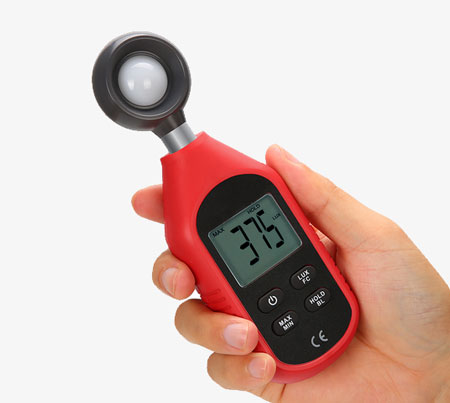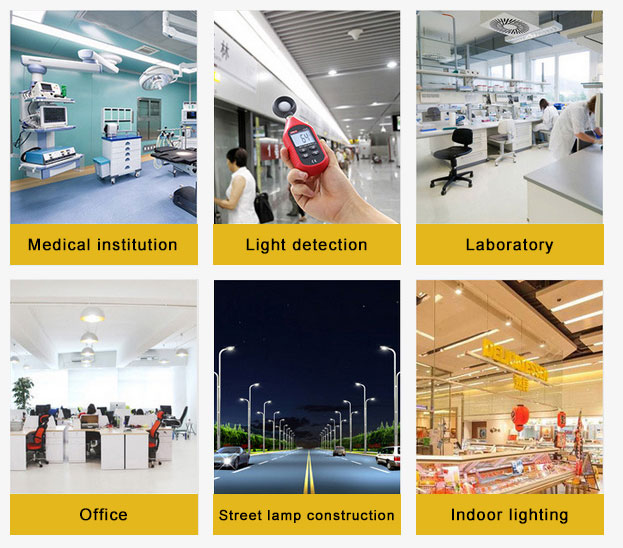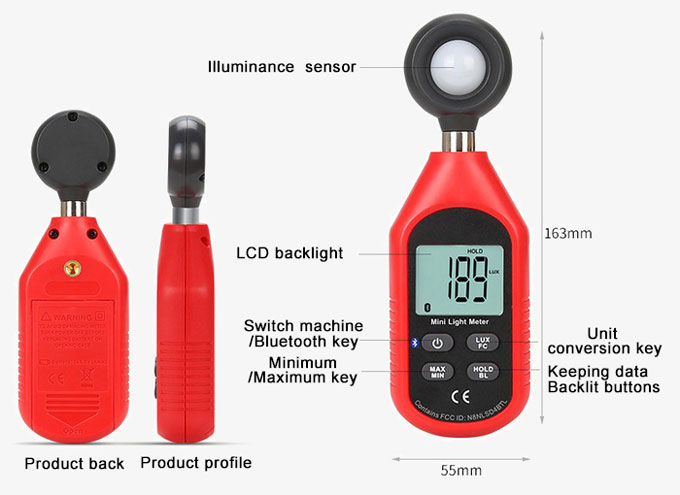The digital illuminance meter features a high precision sensor and an intuitive digital display which effectively measures light intensity and displays the results in Lux or FC. This light intensity meter is both accurate and easy to use, providing users with the data they need to create the perfect lighting conditions in any situation.

- Digital lux light meter with backlit LCD display.
- Maximum and minimum value display.
- Automatic switch-off, low voltage indication, overload indication.
- Switching between LUX/FC measurement units.
- The use of coated filter technology makes the light meter more stable and accurate.
Application
Lux meters are widely used for light monitoring and measurement in lighting enterprises, agriculture and livestock, industry and mining, laboratories, offices, medical institutions, home applications, street lighting construction and other industries.

- Model: SISCO-LM-UT383
- Illuminance Measurement (Lux): 0~199999 Lux
- Illuminance Measurement (FC): 0~19999 FC
- Measurement Accuracy: ±(4%+8)
- Data Retention: √
- Auto Range: √
- Automatic Shutdown: about 10 minutes
- Low Voltage Display: √
- Maximum Value: √
- Minimum Value: √
- LCD Backlight: √
- Power Supply: Number 7 battery x 3
- Body Weight: 118g
- Body Size: 160x50x28mm
Dimension

Q1: What is a lux meter and how does it work?
A1: A lux meter, also known as an illuminance meter, is a device used to measure the amount of light falling on a surface. It works by using a photodiode or photovoltaic cell to convert light energy into an electrical signal, which is then processed and displayed as a reading in lux units.
Q2: What are some common applications of lux meters?
A2: Lux meters are commonly used in a variety of industries and settings, including photography, film production, architecture, and interior design. They are also used in industrial settings to ensure proper lighting levels for worker safety and productivity.
Q3: How to calibrate a lux meter?
A3: Calibrating a lux meter typically involves comparing its readings to a known standard light source of a specific brightness level. This can be done using a calibration light box or similar device, and the process may vary depending on the specific type and model of the lux meter being used. It is generally recommended to have a lux meter professionally calibrated on a regular basis to ensure accuracy.
Tips: How often should a light meter be calibrated?
According to industry standards and guidelines, it is recommended to calibrate the lux meter at least annually, or after any significant change in the working environment or conditions. However, high precision applications or critical measurements may require frequent calibration. It is also important to follow the manufacturer's calibration and maintenance recommendations.
Thank you for buying industrial test and measurement equipment on SISCO.com, all products sold by SISCO and the partner cover a 12 months warranty, effective from the date of receiving the products.
What is covered?
SISCO is responsible for providing free spare parts, and free technical support to assist the customer to repair the defective products until the problem is solved.
What is not covered?
- Product purchased from anyone other than a SISCO store or a SISCO authorized reseller.
- Expendable parts.
- Routine cleaning or normal cosmetic and mechanical wear.
- Damage from misuse, abuse or neglect.
- Damage from use of parts other than SISCO approved.
- Damage from use outside the product’s usage or storage parameters.
- Damage from use of parts not sold by SISCO.
- Damage from modification or incorporation into other products.
- Damage from repair or replacement of warranted parts by a service provider other than a SISCO authorized service provider.
- Damage caused by the application environment not meeting the product usage requirements and the failure to perform preventive maintenance.

